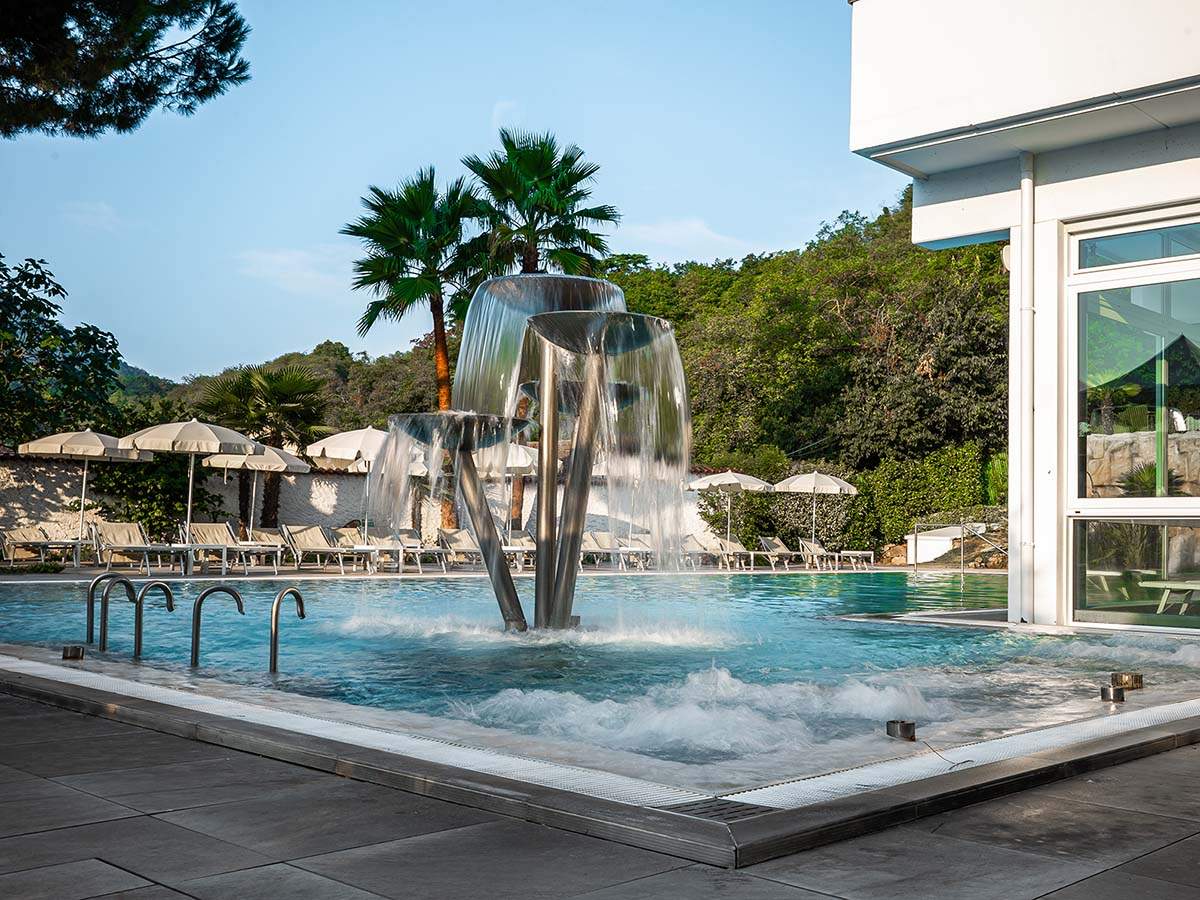The water present in nature is not all the same because it contains dissolved substances and compounds of biological origin in ionic and gaseous states.

Throughout the centuries, dating back to prehistory, it has been observed that this precious element is a true panacea and possesses therapeutic power.
Thanks to chemical and physical analyses, applied more recently, its beneficial properties have also been scientifically proven.
Today, various types of water are classified based on their main characteristics:
Based on this classification, the thermal waters of the Hotel Terme Millepini and generally those of the Euganean Basin belong to the deep underground hyperthermal waters, with a source temperature exceeding 40°C. From a chemical standpoint, they are classified as salt-bromo-iodic due to the presence of a large amount of sodium chloride, iodine, and bromine in the form of iodides and bromides, as well as other elements including calcium sulfate, bicarbonates, sulfides, strontium, and lithium in smaller quantities, with a total dissolved solids at 180°C of about 6g/l of dissolved salts.
The concentration of all these elements is measured in degrees Beaumé, with each degree corresponding to 11 grams of salts per liter of water.
The biological action of salt-bromo-iodic water is predominantly anti-inflammatory, which represents its main indication. This action can be observed in various bodily systems; it stimulates the immune system and mucous secretion and has anti-edematous and resolving effects.
The thermal water of the Euganean Baths is not used for hydrotherapy or against various forms of psoriasis.
Some studies conducted on this precious element have shown that salt-bromo-iodic waters can be considered a useful remedy against recurrent and chronic rhinosinusitis. In this case, the waters are diluted, as their concentration is much higher than necessary.
Very interesting is also their disinfectant action against bacteria and fungi, and antiseptic action; their use in various therapies spontaneously resolves some types of inflammation, also offering for a certain period of time a sort of protection against external and internal pathogens. The water in the thermal pools has the same characteristics and active principles as the water used for thermal treatments; bathing in the pools of the Hotel Terme Millepini can bring benefits not only to adults undergoing mud balneotherapy but also to children. An example of this is the fact that courses for mothers and newborns are held in the hotel pools throughout the year.
The extraordinary therapeutic value of the waters and mud is also due to the severity of the regulations governing thermal extraction, avoiding indiscriminate use of resources and their purification.
The water from the Hotel Terme Millepini flows at 87°C, and like all the water from the Euganean Basin, it must be necessarily cooled to be administered for treatments and used in the pools. This cooling process occurs through the use of heat exchangers, where the primary water releases excess heat, bringing it to the optimal temperature for its various uses; all the "released" heat is used to heat water for sanitary use and, during the winter months, the various indoor environments of the structure, thus avoiding wasting energy and preserving the environment with the use of polluting substances.
A study conducted by the University of Padua and the Centro Studi Pietro D’Abano has shown that the water from the Euganean Baths comes from the uncontaminated basins of the Prealps, which are located at about 2000 meters above sea level. They originate from the rains that fall on the Lessini Mountains of the Small Dolomites, flow underground for about 80 km, and at a depth of 3000 meters, resurface in the springs of Abano and Montegrotto Terme.
During this long journey that lasts thousands of years and crosses the limestone rock, the meteoric waters, loaded with geothermal energy, can reach temperatures of up to 200°C in some stretches, and they are enriched with the essential mineral salts for the production of the microflora, a unique and indispensable element for the processing and maturation of the famous DOC thermal mud.
|
Water temperature pH Electrical Conductivity at 18 °C Fixed Residue at 180 °C Fixed Residue at 550 °C Sodium Ion (Na+) Potassium Ion (K+) Calcium Ione (Ca2+) Magnesium Ion (Mg2+) Ammonium Ion (NH4 +) Iron (Fe) Nitrite Ion (NO2 -) Nitrate Ion (NO3 -) Sulfate ion (SO4 2-) Chloride Ion (Cl-) Hydrogen Carbonate Ion (HCO3-) Bromide Ion (Br-) Iodide Ion (I-) Hydrogen Sulfide (H2S) Silica (SiO2) Alkalinity (mL HCl 0.1 N/L) Total Hardness Oxidizability Organic Substances Cryoscopic Delta Osmotic Pressure |
77°C 7,1 7042 µS/cm 5,050 g/L 4,340 g/L 1,239 g/L 0,088 g/L 0,366 g/L 0,080 g/L 0,0027 g/L <0,05 p.p.m. Abaent absent 0,980 g/L 2,176 g/L 0,169 g/L 13,6 mg/L 0,82 mg/L 1,67 mg/L 0,051 g/L 27,7 120 °F 7,40 mg/L 0,3310 g/L -0,23 °C 3,10 atm. |